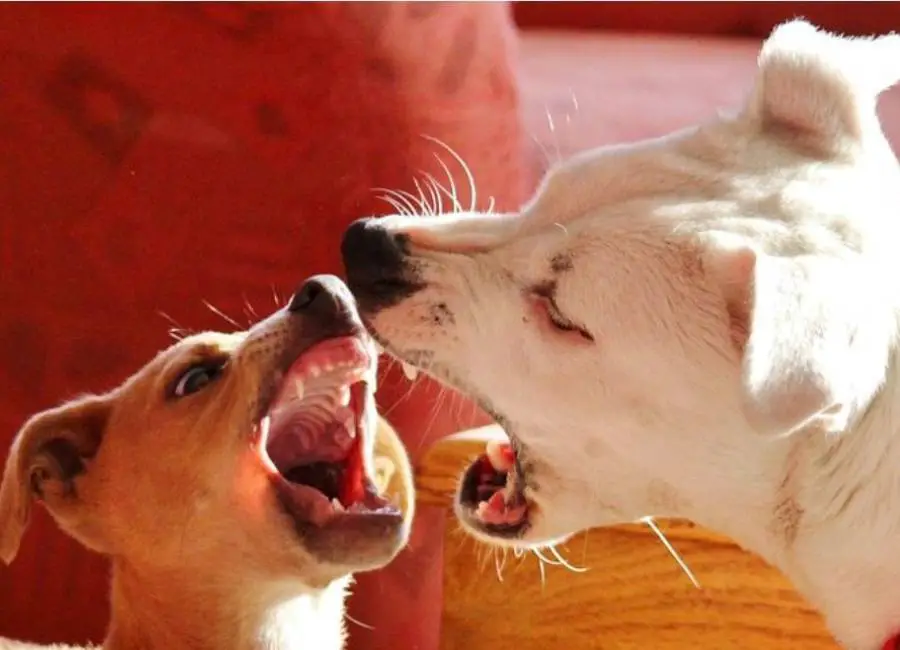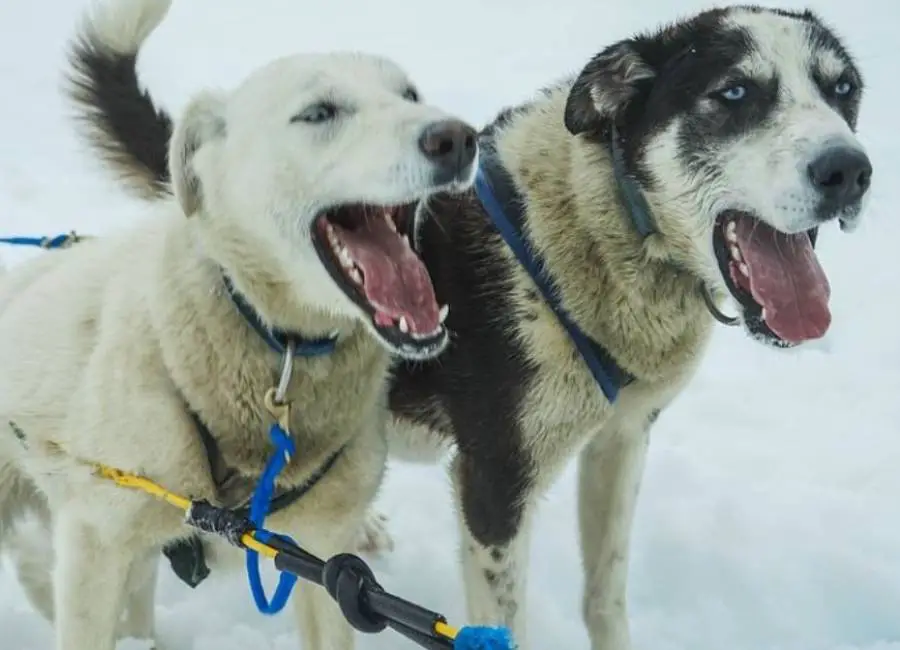12 Tips On How To Stop My Dog From Barking At Other Dogs

How to stop my dog from barking at other dogs is exactly what this post aims at resolving.
When thinking of how to stop your dog from barking at other dogs you should first try to understand the reason for such an attitude.
Sometimes when dogs bark at other dogs is just out of curiosity and not really aggression.
Before we continue on ways to stop your dog from barking at other dogs, let me quickly run over some common reasons why your dog may be barking at other dogs.
Why dogs bark at other dogs

I am going to outline some of the most common reasons why dogs bark at other dogs.
We have already explained why dogs bark at other dogs in detail so try and find time to go through it.
That being said, here are some of the most common reasons why dogs bark at other dogs:
- Poor socialization
- Curiosity
- Frustration
- Self-defense
- Excitement
- To communicate
- To get attention
- Fear
- Wanting to play
- Sign of aggression
- Territorial reasons
As you can see from the list there are a lot of reasons why dogs bark at other dogs.
We won’t go further in these reasons because we have treated them in another post.
With these reasons in mind let’s look at some common ways to stop your dog from barking at other dogs.
How To Stop My Dog From Barking At Other Dogs
The first thing you should consider in trying to stop your dog from barking at other dogs is to figure out why your dog is barking in the first place.
You should also consider your dog’s physical state and health condition.
Here are a few tried-and-true methods to get your dog to quit barking at other dogs:
1. Breaking your dog’s attention
When dogs bark at other dogs their whole attention is focused on the dog they are barking.
One of the most common and simple ways to stop your dog from barking at other dogs is to always break their attention.
You can call it distracting them, this can be done using high-quality treats or pieces of meat to get their attention.
Remember this is just a temporary measure and won’t last if you have not properly trained your dog to listen to you.
You can also pick up your dog when giving him treats, just do anything you can to get his attention.
2. Creating a distance between the two dogs
One of the common things you should do if you have tried to get your dog’s attention, and it’s not working is to take your dog away.
If your dog is not showing any signs of slowing down you should create a distance between the two dogs as far as possible.
This distance between the two dogs will help your dog to calm down temporarily but won’t resolve the situation.
Taking your dog away from the other dogs is just a quick fix, to completely resolve this you should invest time in socialization.
3. Dog-to-dog training
Training between dogs should take place in a controlled setting with a well-behaved dog.

Try not to exert too much or too rapid pressure on your dog during dog-to-dog training.
Don’t forget to praise and encourage him if he aggressively avoids other dogs by making evasive maneuvers.
This might involve kissing, sniffing, gazing, or avoiding eye contact with other canines.
Start by rewarding all evasive actions, even the tiniest ones like a fleeting look.
It is best to carry a dog if it refuses a treat from you since that indicates that it has gone too far.
Treats can only influence your dog’s behavior when it happens purposefully as opposed to nature.
4. Train your dog to follow commands
As soon as you can, teach your dog a stop command or sign to assist you to reduce unnecessary barking.
A dog that is barking will assume you are entertaining yourself if you scream at it. Never correct someone else for barking.
To get your dog to stop, speak to him firmly, calmly, and at a constant volume. Teach your dog the meaning of stillness.
The majority of canine breeds struggle with understanding when to “shut up,” despite their intelligence.
Instead, tell them to keep quiet, and when they do, compliment them.
Any stop word can be employed, but it must only be one word—never two or more.
The words Stop, Sit, Go, and Come have a big impact on a dog’s life, so try your best to make sure your dog gets used to them.
If you teach your dog to respond when they see other dogs or pets, they will.
I can stress much on the importance of socialization of your dog from the puppy stages.
Lack of socialization is actually one of the major reasons why dogs bark at other dogs.
The main advantage of early dog socialization is that it teaches your dog to be calm, loving, and confident.
A dog that has been properly socialized will be friendly to strangers and at ease with other canines.
Remember that one of the most typical problems with dog behavior is excessive barking.
The following are the most often used methods for socializing your dog:
- Take your dog to meet other dog owners as frequently as you can.
- Bring your dog to dog shows.
- Visit a dog park with your pet.
- It’s a great idea to invite your neighbors who own other animals.
- Take your dog camping.
- Join your dog during puppy classes.
- Play him some dog-related instructive films.
6. Train yourself to be calm when your dog is barking
You should understand by now that dogs are intelligent and most of them can read your emotions.
You should train yourself to be calm or remain calm around other dogs.
Your dog might be barking at other dogs because he thinks he’s protecting you from the other dog.
Therefore, the type of energy your dog perceives from you around other dogs matters.
For example:
You let your dog walk on a leash and when you approach other dogs you become tensed and try to tighten up the leash.
Your dog reads such energy and senses the panic which fires him up to increase his barking toward other dogs.
When you approach other dogs just make sure you remain calm, this assures your dog that everything is fine.
7. Practice avoidance with your dog
Practicing avoidance is one of the best ways to help your dog to stop barking at other dogs.
Start by teaching your dog to avoid unnecessary distractions and focus only on you.
Make sure you reward your dog each time he ignores things and focus on you.
When you are good to go you can practice it with another dog, remember if you teach your dog to avoid things it will be important when teaching him to ignore other dogs.
8. Teach your dog to follow rules limitations and boundaries
Understanding your dog’s perspective or attitude is crucial if you want to get them to quit barking excessively.
If you don’t properly socialize and teach your dog, it will become dominant and constantly bark to protect you.
If you want your dog to see you as a leader and think you are in charge of the situation, you need to modify the way you think.
By establishing guidelines, limitations, and boundaries, you may remodel your dog’s thought processes.
Therefore, continually remind your dog to observe the rules in order to stop them from barking needlessly.
9. Greetings with other dogs should be brief
When your dog is politely meeting other dogs, you may want to interrupt him from time to time to catch his attention.
Repeat this as needed to keep your dog from losing control and getting furious.
If your dogs are excessively concentrated on going and staying put, you have delayed too long to begin a break.
Positive pauses are useful for handling human greetings and keeping your dog out of inappropriate or unsanitary situations.
10. Teach your dog to only focus on you
It is important to train your dog to always focus on you either at home or outside.
Focusing on you entails answering your call no matter what, you can start this by rewarding your dog.
Remember to always use positive energy when teaching your dog, if you are too soft then your dog can show dominance.
Let’s say you are working on a path and your dog sees other dogs and starts barking.
The best thing to do is to call him by his name and let him focus on you, this can only happen if you have done proper training.
11. Don’t punish your dog for barking at other dogs
It is inappropriate to chastise your dog for barking at other dogs.
Your dog can only naturally communicate with you by barking.
Never use any form of negative reinforcement to discipline your dog for barking at other dogs.
The simplest way to get your dog to stop barking is to utilize prizes and positive reinforcement.
You shouldn’t punish your dog for trying to speak with other dogs, even if you give them the “stop” command or make a loud noise.
12. Invest time in obedience training
Sessions of obedience training are essential if you want to get a dog to quit barking at other canines.
Throughout the training, teach your dog a strong stop word so that when you use it, he can run away from a situation with ease.
The most important thing is to make sure your dog comprehends whatever terminology you come up with to help you control him.
These phrases include, for example: “Leave it,” “Stop,” “Achi,” “No,” “Go,” “Down,” etc.
Things you should avoid when Your dog is barking at other dogs
Here are a few things you should never do when your dog is barking at other dogs:
- Punishing your dog
- Shouting at your dog
- Allowing your dog to drag you closer to the other dog.
- Using an anti-bark collar.
- Don’t beat your dog for barking at other dogs.
Last words…
Whatever the cause, it’s critical to keep in mind that barking is a habit that dogs exhibit naturally, and we should never penalize them for it.
Instead, we must make an effort to comprehend the significance of their barking and seek to constructively reorient their behavior.
They can be happy to see another dog or they might be feeling possessive.
Understanding the cause of your dog’s barking will help you stop it.
Using a behavior modification strategy like clicker training or positive reinforcement may help you get your dog to stop barking at other dogs if you’re having problems training it not to.
Begin by praising your dog for not barking at other dogs and gradually reduce the awards as they improve.




![How to Stop Aggression in Dogs [12 Strategies] Stop Aggression in Dogs](https://petcreeks.com/wp-content/uploads/2023/10/guard-dog-3494494_640.jpg)
![Can Beagles Swim [Helpful Tips] Can Beagles Swim](https://petcreeks.com/wp-content/uploads/2023/05/Can-Beagles-Swim-768x555.jpg)
